
A/B Testing: How to convert your website visitors into qualified leads
Do you happen to see the same person every day while taking your daily exercise? You smile at each other but, as long as you don’t swap telephone numbers, you won’t be able to enter into a relationship that extends beyond that.
The same goes for your website. Anonymous website visitors can interact with it, but, as long as they don’t provide their contact details, you can’t create a relationship that lasts beyond the individual visit. This means you’re missing out on the opportunity to personalize, using various methods like A/B testing, their customer journey and on any associated potential for conversion. Instead, if you want to successfully turn the anonymous visitors on your website into identified prospects, then you need to build an effective lead-collection strategy. This means rethinking how you obtain visitor information on your website. In this article I’ll review the most effective methods for getting your anonymous visitors’ contact details, without impacting your relationship.
1 What is lead generation?
On your website, 96% of visitors are anonymous, meaning that you cannot identify them and recognize them on their next visit.
Lead generation encompasses all practices aimed at collecting business leads via your website. An anonymous visitor becomes a lead once you have their details such as an email address or other information (address, telephone number, etc.).
It is vital to collect leads, since by developing a database of contacts it is possible to nurture the relationship with each identified visitor and to personalize their experience to increase your conversion rates.
2 Why collect leads?
Your ultimate goal is to maximize conversions on your website. To do this, you must be able to accurately meet the needs and expectations of each of your visitors: in other words, you must be able to personalize their experience. However, understanding these individual needs and expectations is more difficult if your visitors remain anonymous. That’s why building up a database of customer information is a key stage of your digital marketing strategy.
GET TO KNOW YOUR AUDIENCE BETTER
When you collect information from your visitors, via a form or even if they create an account, you are getting to know your audience better:
- Who are the visitors to your website?
- What are they looking for and what are they doing on your website?
- What type of content/products are they interested in?
- What channels have they used to provide their details?
By using this information, you will be able to optimize both your website and the way in which you collect and nurture your leads.
You can then use AI to turn your previously anonymous visitors into identified prospects.
French retailer Cdiscount provides the perfect example. It draws on its knowledge of its existing subscribers to recruit new ones to its loyalty program. Kameleoon’s predictive algorithms make it possible to find correlations between the behavior of subscribers and that of anonymous visitors. Through this Cdiscount can identify, among its huge number of anonymous visitors, those showing the greatest likelihood of subscribing to the loyalty program, and the best way to present the subscription offer to them.
GO AT YOUR CUSTOMERS’ PACE (LEAD NURTURING)
Most of the visitors coming to your website for the first time aren’t yet ready to convert. So you must put personalized actions in place to lead them to conversion at their own pace. However, if your visitors are not identified you won’t be able to understand their progress through the conversion funnel or to put in place the right actions to convert them.
This makes it vital to collect your visitors’ contact details in order to stay in touch with them beyond their website visit, personalize their experience and adapt to their individual pace and expectations. This is known as lead nurturing.

Sales made with lead nurturing have an order value that is 47% higher compared with those made without, making it an important lever for your marketing strategies according to Annuitas. Once contact details are stored in your database, you are going to be able to:
- Segment your audience to identify the leads with high added value.
- Model each visitor’s journey through your conversion funnel.
- Put in place personalized actions adapted to each visitor to encourage their conversion.
KNOW YOUR CONTACTS ON EVERY CHANNEL IN ORDER TO PERSONALIZE
Consumers are increasingly demanding. They expect to receive personalized experiences that are adapted to their browsing behavior, interests or the context of their visit. Delivering this benefits the bottom line - 93% of companies see an increase in conversions thanks to personalization. To be able to personalize your visitors’ experience at every interaction and on every channel, they need to be logged in. You must therefore ask them to log into your website, which can be difficult to achieve.
However, with the Kameleoon platform, it is possible to personalize the experience of anonymous visitors by drawing on ‘hot’ behavioral data (pages viewed, mouse movement, context of visit, source channel, etc.) and visitor cookies. So, if you identify that a visitor has come to your website via an advert on social media, you can show them this same advert on your homepage. Moreover, Kameleoon allows you to show a visitor who has been exposed to a personalization on your website the same message in a retargeting or display campaign (such as through Google Ads or Facebook) we can identify the likelihood of conversion in just 15 seconds.
When a visitor is logged in, the Kameleoon platform enables you to take into account other types of ‘cold’ data (purchase history and frequency, behavior on other devices and during previous visits, questionnaires, etc.). You can then offer the same experience across all devices (desktop, mobile, tablet) and touchpoints (website, application, email, social media, etc.).
3 Offering a mutually beneficial exchange (lead magnet)
To gather information on your visitors and to encourage them to log into your website, there are several tools you can use, including forms, landing pages and floating bars. Obviously optimizing these different elements is necessary, it will not be enough to get your visitors to give you their contact details.
The different types of lead magnets
You must offer anonymous website visitors some benefit in return through a lead magnet, such as:
- Inviting the visitor to create a personal account to receive exclusive offers reserved for subscribers/customers.
- Having contact forms in place to request a demo.
- Inviting them to subscribe to your newsletter so they can receive updates and be the first to hear about any good deals.
- Organizing a competition in which the participants have to enter their contact details.
- Creating landing pages with forms to enable users to download your resources or sign up for a webinar.
- Presenting all visitors with a questionnaire to obtain their feedback on your website or products and, at the same time, giving their contact details.
- Suggesting they leave their email address when a product is out of stock.
Obviously, under GDPR these all need to be clear and transparent in terms of how you will use their personal information.
OFFER LEAD MAGNETS THAT LIVE UP TO YOUR VISITORS’ EXPECTATIONS
With AI-driven personalization, it is possible to understand visitor expectations in-depth and to then provide an offer that delivers the greatest possible value to the visitor. Predictive algorithms use visitor data to calculate each individual’s interest in a product, service or offer. You can then provide a lead magnet that matches the visitor's interests.
On a travel website, it could be the chance to download a brochure based on the pages they have been browsing. For example, if a visitor shows an interest in a trip to Spain, they can be shown a pop-in to download the brochure for that particular destination. On an e-commerce website, you could offer a discount coupon for the type of product that they have been viewing, in exchange for subscribing to your newsletter.
All of these actions can have a strong impact on your visitors, but only if they can be pushed to the right people at the right time. Not all visitors function at the same pace and they are not all looking for the same thing on your website. Depending on the approach adopted, you can deliver these messages in a more or less contextualized manner. This is what we’re going to look at right now.
4 How to collect your leads: mass approach or one-to-one marketing?
Regardless of how you want to collect your visitors’ personal details, the most important thing is to do it at the right point in their customer journey and in a manner that speaks to them personally. To encourage visitors to give you their personal details, several approaches are possible:
- Undifferentiated actions, pushed to all traffic in the same conditions
- Segmented actions, which are only aimed at one type of visitor or are triggered only when the visitor has accomplished certain actions
- Individualized actions, which are triggered depending on the visitor’s behavior, their conversion probability or their interest in a product, a message, or an offer, in real-time.
1. UNDIFFERENTIATED ACTIONS
To get your visitors’ data, it is possible to put in place mass actions that are pushed to the entire audience without specific conditions. An example of this is websites that display a newsletter subscription pop-in as soon as a visitor lands on the homepage. Another example is placing a contact form in the footer or via a CTA.
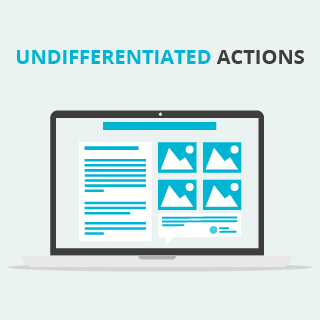
This method is not ideal - visitors have not yet had time to discover your website but are already being disturbed by a pop-in. You can’t use the context of your visitor’s experience or take their interests into account, missing out on potential leads.
On the plus side however, this method enables you to attract the attention of all visitors as soon as they land on the website. However, your goal shouldn’t be to create as many leads as possible, but rather to obtain quality leads that you are then going to be able to convert.
An example: CRESUS
Cresus, a French website for buying and selling second-hand luxury watches, needs to recruit the maximum number of contacts so that it can then nurture its relationship with its prospects (those selling watches). The brand has therefore created a competition pop-in that is displayed to all visitors as soon as they land on the website.
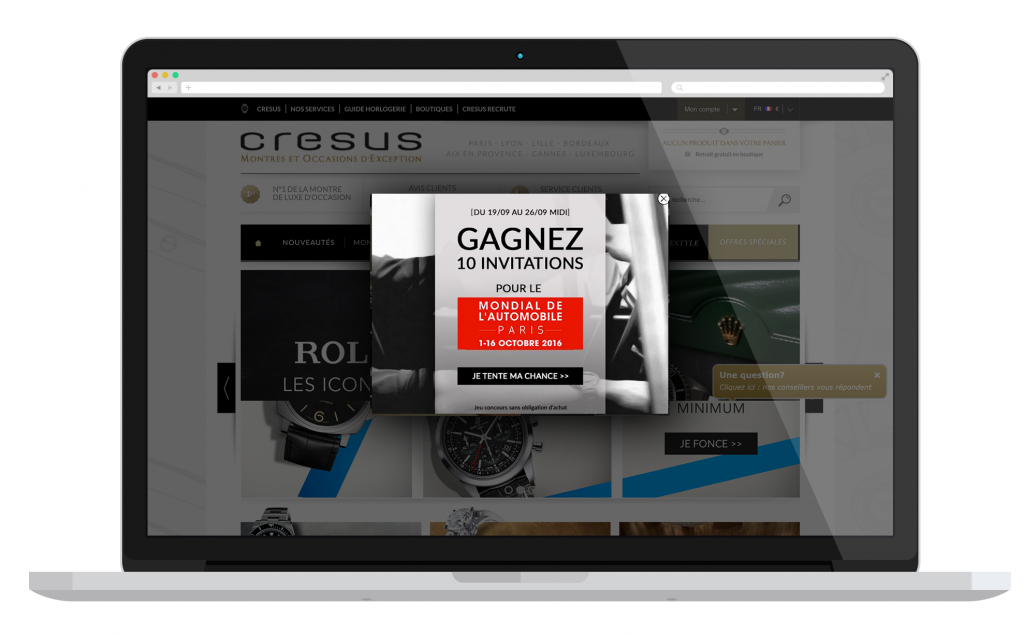
Through this tactic, Cresus has seen 69% of visitors click through to the competition’s landing page. The undifferentiated action has therefore generated a large quantity of leads, but there is no way of knowing their quality.
2. SEGMENTED ACTIONS
It is possible to launch personalized actions to encourage your visitors to enter their information while adapting to their pace and position in the customer journey. You can set criteria so that the contact request is triggered only at a certain point or displayed only to a certain type of visitor.

This approach enables you to qualify your contacts, since you can set certain conditions such as:
- The visitor must have viewed at least three pages
- The visitor must have spent a certain period of time on your website
- Only visitors who are about to leave your website can see the pop-in
- Only visitors who have already downloaded a resource will see the pop-in
After viewing content or spending a certain amount of time on the website, visitors will have a better understanding of whether or not they want to stay in contact with you. Through this approach you are making sure that the visitors who are shown your pop-in are qualified enough to engage with your brand.
An example - Belambra
To encourage visitors to return to its website and to nurture a relationship with them, French holiday company Belambra has put in place a personalized action to encourage visitors to subscribe to its newsletter. To maximize conversions the subscription pop-in was only triggered once a visitor had viewed more than two pages or moved the cursor out of their browser window.
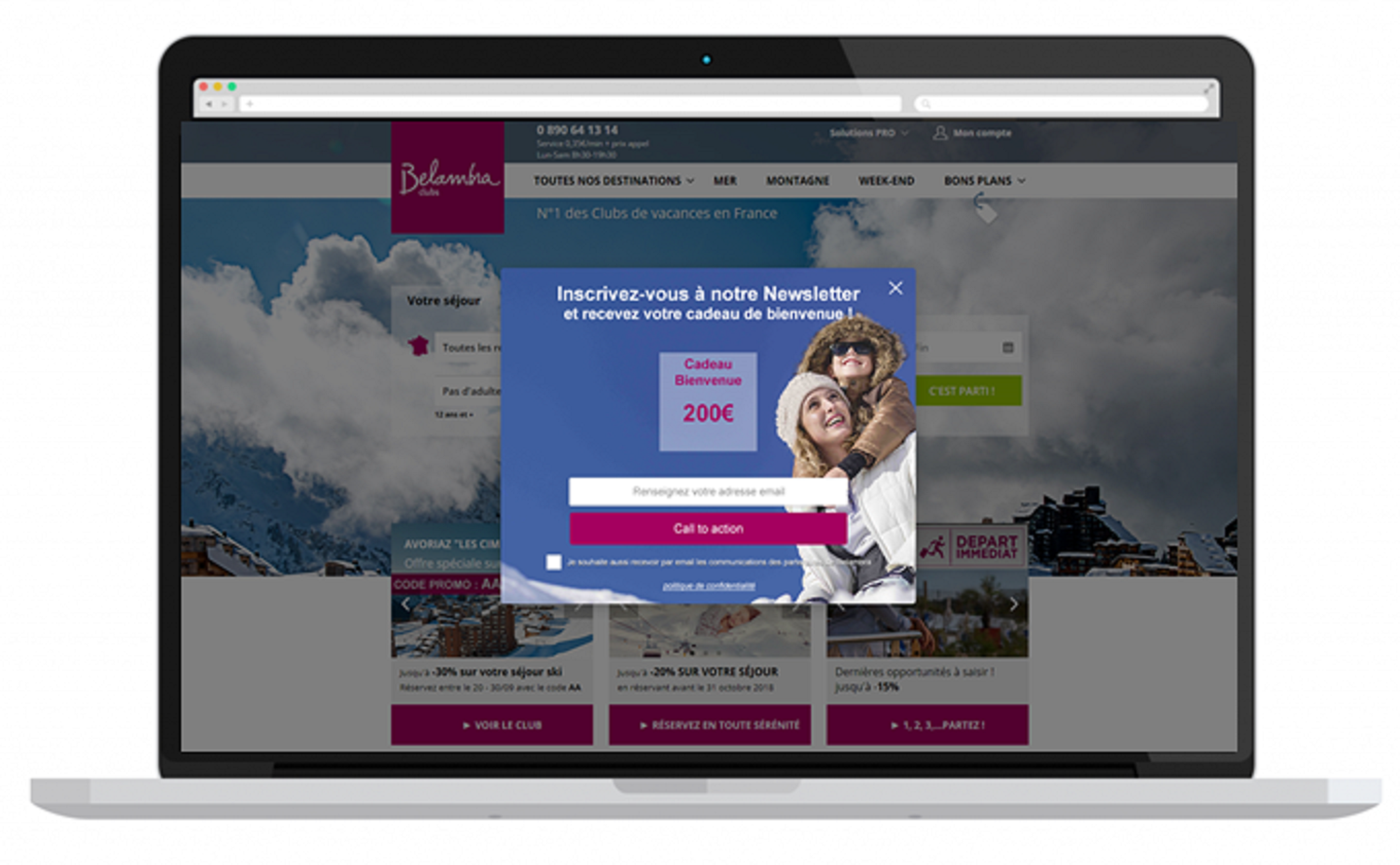
The segmented action had an immediate positive impact on newsletter subscriptions, without impacting engagement or the user experience.
3. INDIVIDUALIZED ACTIONS
With Kameleoon, it is possible to put in place individualized actions that are triggered in real-time, based on the behavior of each visitor. Through AI-driven personalization brands can measure their visitor’s conversion probability or even their interest in a product, message or offer.
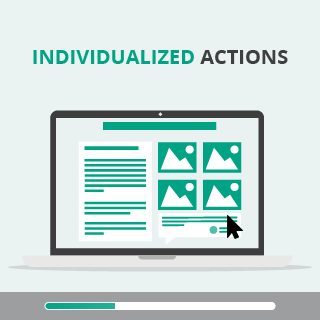
Kameleoon’s predictive algorithms take into account ‘hot’ intent data (linked to the current visit), which is the most important when it comes to detecting a conversion probability or an interest in an offer or a product.
It is also possible to aggregate ‘cold’ data from your CRM or DMP as well. The algorithms then compare the behavior of visitors and find correlations between those who are identified, i.e. those who have provided their personal information, and anonymous visitors. From this analysis, algorithms can determine the conversion probability or level of interest, displayed through the Kameleoon Conversion Score (KCS)™.
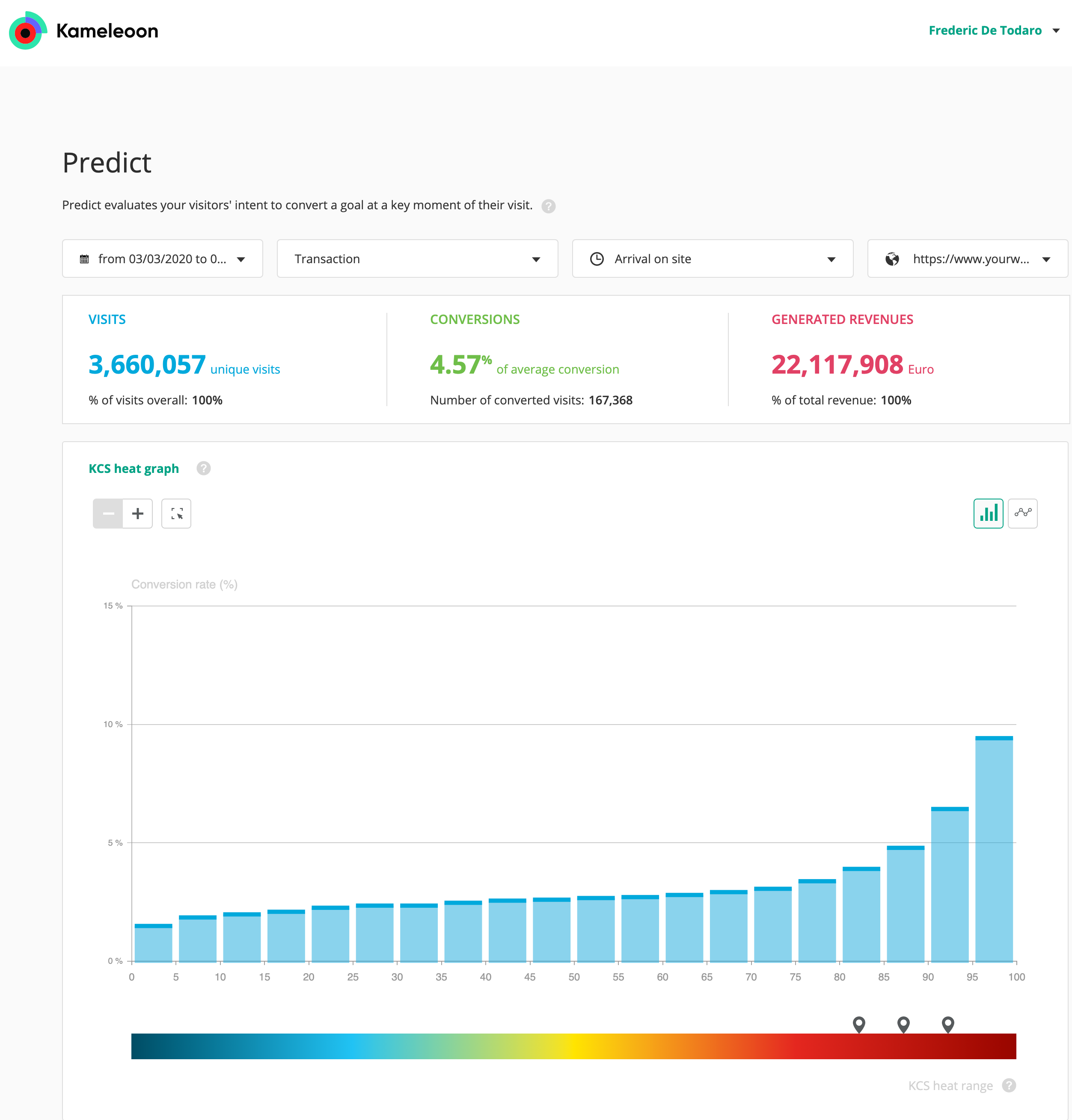 A visitor with a high score will have a high probability of converting. It is then possible to adapt your messages to each visitor. As soon as a visitor is identified by the algorithm as ready to engage, you can display a pop-in or personalized banner to suggest that they share their contact details.
A visitor with a high score will have a high probability of converting. It is then possible to adapt your messages to each visitor. As soon as a visitor is identified by the algorithm as ready to engage, you can display a pop-in or personalized banner to suggest that they share their contact details.
An example: Toyota
Toyota uses each visitor’s Kameleoon Conversion Score to adapt to where each visitor is in the customer journey. Kameleoon’s AI calculates a score for each visitor according to their behavior and all available data. This corresponds to the visitor’s level of engagement, and the Toyota teams trigger different actions depending on the score reached.
For example, when a visitor’s KCS is between 0 and 20, they are considered to be “cold”, meaning that they are not at all ready to convert. In this situation, no action is triggered as Toyota doesn’t believe that the visitor is ready to be exposed to a marketing message. If the visitor’s KCS is between 20 and 30, they are seen to be starting to feel tempted and they will be invited to request a brochure so that their personal details can be collected.

Above this score, the brand invites the visitor to use the vehicle comparison feature or even to request a test drive. In this way, contact is initiated only when the visitor is ready, which translates into a score above 20. This enables the team at Toyota to qualify their leads in advance without bothering visitors who are not yet sufficiently advanced in the engagement process.
AI-driven personalization thus allows you to trigger the right actions at the right time for each visitor. With this approach, you are making sure that you gather qualified leads without disturbing their browsing experience, delivering a seamless experience that improves the visitor journey and your bottom line.





